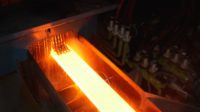U.S. and European Union officials have reached a deal to end current steel tariffs and replace them with a new tariff-rate quota arrangement.
President Joe Biden and European Commission President Ursula von der Leyen announced the deal on Oct. 31 at the G20 summit in Rome and it will take effect on Jan. 1, 2022, replacing tariffs added under then-President Donald Trump in 2018.
Under the agreement, EU steel may be imported with no tariff, if it is within a quarterly quota that will be calculated each year based on U.S. and global steel demand data from the World Steel Association. The deal sets the quota at 3.3 million metric tons to start.
Any steel imported beyond the quota will be subject to a 25% duty, as will any steel products that originate elsewhere, such as in China, and are finished in Europe. The deal also sets a similar arrangement for aluminum, but with a 10% duty on over-quota products.
Philip K. Bell, president of the Steel Manufacturers Association, said in a statement that the deal sets the stage to solve issues such as global excess steel capacity and the diversion of steel imported from China through the EU. However, with the deal allowing for some steel products to be excluded from the quotas and duty, he added that the U.S. officials should “narrow the exclusion process substantially.”
“Many exclusions will not be needed as new investments by the U.S. industry come on line,” he said.
Kevin Dempsey, president and CEO of the American Iron and Steel Institute, said in a statement that he hopes the U.S. and EU will hold countries, such as China, “which "employ trade-distorting policies to account” now that they have reached a deal.
Tom Conway, president of United Steelworkers International, said the union supports the deal.
“This new arrangement … will create a framework that will ensure U.S. domestic industries remain competitive and able to meet our security and infrastructure needs,” Conway said in a statement.
The agreement also allows for further talks between the U.S. and EU to address the steel industry’s carbon intensity. The sides say they will hold negotiations focused on greenhouse gas emissions related to steel and aluminum within two years.
“This deal … demonstrates how, by harnessing our diplomatic and economic power, we can reject the false idea that we can’t grow our economy and support American workers while tackling the climate crisis,” Biden said. “We can do all three of those things.”
As part of the deal, EU officials also agreed to end retaliatory tariffs on U.S. products set in place in response to Trump administration tariffs, and both sides agreed to suspend disputes they initiated against each other with the World Trade Organization.
The US Dept. of Commerce said the U.S. is still working on issues related to steel and aluminum with the U.K. and Japan.





Post a comment to this article
Report Abusive Comment